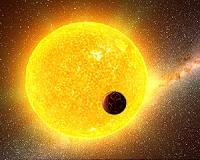 |
Paris (AFP) April 12, 2011 Astronomers said on Tuesday they believed the first galaxies formed just 200 million years after the Big Bang, a finding that challenges assumptions of how the Universe grew from infancy into childhood. Their evidence comes from a remote galaxy whose glimmer of light was teased open to reveal the presence of truly ancient stars. "We have discovered a distant galaxy that began forming stars just 200 million years after the Big Bang," said lead author Johan Richard, an astrophysicist at the Lyon Observatory, southeastern France. "This challenges theories of how soon galaxies formed and evolved in the first years of the Universe. It could even help solve the mystery of how the hydrogen fog that filled the early Universe was cleared." The oldest galaxy previously detected and confirmed was created some 480 million years after the Big Bang. To all appearances, the new finding could lay a claim on being the record-beater. But no such claims are being made because the discovery was made indirectly, rather than through direct observation, Richard told AFP. Richard's team used a technique called gravitational lensing. Under this, the light from the galaxy was observed by the Hubble and Spitzer orbital telescopes after it had been amplified by the gravitational pull of a second galaxy that, by sheer chance, lay on a direct line with Earth. Without this gravitational amplification, the light from the distant galaxy would have been undetectable because it was so faint. Using the Keck II spectroscopic telescope in Hawaii to analyse the light, the team found that the galaxy's redness -- a telltale of age -- gave a reading of 6.027. In layman's terms, this says the light arriving here today was emitted when the Universe was 950 million years old. By comparison, the earliest known galaxy, reported in January, had a whopping "redshift" of 10.3. However, hidden in the bundle of infrared data from Spitzer were signs that many stars in the galaxy were surprisingly old and relatively faint. "This told us that the galaxy was made up of stars already nearly 750 million years old -- pushing back the epoch of its formation to about 200 million years after the Big Bang, much further than we had expected," said Eiichi Egami of the University of Arizona. Under the Big Bang theory, the Universe originated in a superheated flash around 13.7 billion years ago and started to expand. After the nascent cosmos cooled a little, electrons and protons teamed up to form hydrogen, the most primitive element, and for hundreds of millions of years, this gas filled the Universe. How the fog lifted is one of the big mysteries. One idea is that radiation from galaxies ionised the gas. But this would have been impossible as there were clearly not enough galaxies available to do so. The answer, in fact, could be simple, said Jean-Paul Kneib, a Marseille-based astrophysicst with France's National Centre for Scientific Research (CNRS). "It seems probable that there are in fact far more galaxies out there in the early Universe than we previously estimated -- it's just that many galaxies are older and fainter, like the one we have just discovered," he said in a press release. "If this unseen army of faint, elderly galaxies is indeed out there, they could provide the missing radiation that made the Universe transparent to ultraviolet light."
Share This Article With Planet Earth
Related Links Stellar Chemistry, The Universe And All Within It
 Kepler Helps Astronomers Update Census Of Sun-Like Stars
Kepler Helps Astronomers Update Census Of Sun-Like StarsAmes IA (SPX) Apr 11, 2011 NASA's Kepler Mission has detected changes in brightness in 500 sun-like stars, giving astronomers a much better idea about the nature and evolution of the stars. Prior to Kepler's launch in March 2009, astronomers had identified the changes in brightness, or oscillations, of about 25 stars similar to our sun in size, age, composition and location within the Milky Way galaxy. The dis ... read more |
|
| The content herein, unless otherwise known to be public domain, are Copyright 1995-2010 - SpaceDaily. AFP and UPI Wire Stories are copyright Agence France-Presse and United Press International. ESA Portal Reports are copyright European Space Agency. All NASA sourced material is public domain. Additional copyrights may apply in whole or part to other bona fide parties. Advertising does not imply endorsement,agreement or approval of any opinions, statements or information provided by SpaceDaily on any Web page published or hosted by SpaceDaily. Privacy Statement |